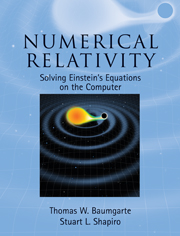Book contents
- Frontmatter
- Contents
- Preface
- Suggestions for using this book
- 1 General relativity preliminaries
- 2 The 3 + 1 decompostion of Einstein's equations
- 3 Constructing initial data
- 4 Choosing coordinates: the lapse and shift
- 5 Matter sources
- 6 Numerical methods
- 7 Locating black hole horizons
- 8 Spherically symmetric spacetimes
- 9 Gravitational waves
- 10 Collapse of collisionless clusters in axisymmetry
- 11 Recasting the evolution equations
- 12 Binary black hole initial data
- 13 Binary black hole evolution
- 14 Rotating stars
- 15 Binary neutron star initial data
- 16 Binary neutron star evolution
- 17 Binary black hole–neutron stars: initial data and evolution
- 18 Epilogue
- A Lie derivatives, Killing vectors, and tensor densities
- B Solving the vector Laplacian
- C The surface element on the apparent horizon
- D Scalar, vector and tensor spherical harmonics
- E Post-Newtonian results
- F Collisionless matter evolution in axisymmetry: basic equations
- G Rotating equilibria: gravitational field equations
- H Moving puncture representions of Schwarzschild: analytical results
- I Binary black hole puncture simulations as test problems
- References
- Index
14 - Rotating stars
Published online by Cambridge University Press: 05 March 2013
- Frontmatter
- Contents
- Preface
- Suggestions for using this book
- 1 General relativity preliminaries
- 2 The 3 + 1 decompostion of Einstein's equations
- 3 Constructing initial data
- 4 Choosing coordinates: the lapse and shift
- 5 Matter sources
- 6 Numerical methods
- 7 Locating black hole horizons
- 8 Spherically symmetric spacetimes
- 9 Gravitational waves
- 10 Collapse of collisionless clusters in axisymmetry
- 11 Recasting the evolution equations
- 12 Binary black hole initial data
- 13 Binary black hole evolution
- 14 Rotating stars
- 15 Binary neutron star initial data
- 16 Binary neutron star evolution
- 17 Binary black hole–neutron stars: initial data and evolution
- 18 Epilogue
- A Lie derivatives, Killing vectors, and tensor densities
- B Solving the vector Laplacian
- C The surface element on the apparent horizon
- D Scalar, vector and tensor spherical harmonics
- E Post-Newtonian results
- F Collisionless matter evolution in axisymmetry: basic equations
- G Rotating equilibria: gravitational field equations
- H Moving puncture representions of Schwarzschild: analytical results
- I Binary black hole puncture simulations as test problems
- References
- Index
Summary
Rotating stars in general relativity are of long-standing theoretical interest. With the discovery of radio pulsars in 1967 and their identification as magnetized, rotating neutron stars, rotating relativistic stars have also become objects of intense observational scrutiny. Radio pulsars have become particularly useful for relativity, since they provide excellent cosmic clocks. The original idea of Baade and Zwicky (1934) that neutron stars could be formed during supernovae events, coupled with the discovery of radio pulsars in some supernova remnants like the Crab, firmly linked rotating neutron stars with stellar collapse and supernovae explosions. Following the detection of radio pulsars, X-ray pulsars were discovered in 1971. X-ray pulsars proved the existence of rotating neutron stars that are accreting gas supplied by a companion star in a binary system. The discovery of the first binary pulsar by Hulse and Taylor in 1974 proved that rotating, relativistic stars can reside in binary systems, making neutron stars even more interesting to relativists. General relativity is required to describe the gravitational field of neutron stars, since their compaction, M/R, where M is the mass and R is the characteristic radius of the star, is large (˜0.1–0.2). Numerical relativity is important for treating many dynamical processes involving neutron stars accurately. It provides a valuable tool for probing neutron star formation from stellar core collapse in a supernova and for tracking the dynamical evolution and assessing the final fate of neutron stars subject to instabilities.
- Type
- Chapter
- Information
- Numerical RelativitySolving Einstein's Equations on the Computer, pp. 459 - 505Publisher: Cambridge University PressPrint publication year: 2010



